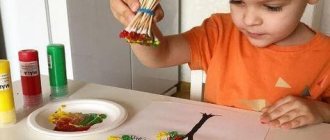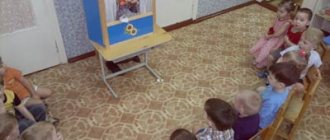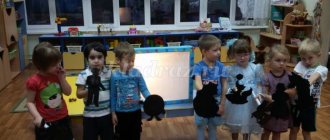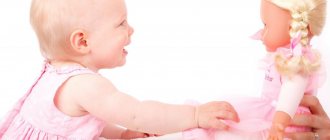Development of creative abilities in children through theatrical activities
The article shows the importance of children's creative potential in accordance with the Federal State Educational Standard. Arguments are given in favor of using theatrical activities for this purpose, in particular theatrical games.
Key words: creative abilities, creative development, theatrical activity.
Relevance . Throughout human history, creativity has been a kind of engine that has helped people move to a new stage. Therefore, creatively active people were often (though not always) held in high esteem. It was their new ideas that showed new goals and transformed reality. And in our time this does not lose relevance. After all, creativity is applicable in all areas of human activity. And no matter how gifted a person is, any abilities require development, including creative ones. It is known that childhood is the most productive period in a person’s life, when the foundations of his future personality are laid and natural abilities are developed. Creativity is no exception.
The Federal State Educational Standard directs us to create favorable conditions for the development of the abilities of each child and his creative potential [1, paragraph 1.6]. In the section Artistic and aesthetic development (clause 2.6), among the assigned tasks, the implementation of the child’s independent creative activity in various directions is indicated: fine arts, musical direction, constructive modeling. In the search for effective methods for developing creativity in children, we must not forget about the theater, which includes all these areas of creative activity. After all, theatrical activity as a source of development of creative abilities is a means that can contribute to the development of children's individuality, the disclosure of their abilities, and creative activity.
Literature analysis. Rubinstein S.L. gave a prominent place to the problem of abilities, considering the problems of inclinations, the development of abilities, the relationship between giftedness and personality, giftedness and mental functions, general and special giftedness [2]. Teplov B.M. identified signs that reflect the essence of human abilities [3, p.9].
Creativity, according to researchers such as V.N. Druzhinina, E.L. Soldatova and others, can be developed. It is especially effective to influence its formation during sensitive periods. Preschool age and adolescence are such periods [4].
Children's creativity is one of the pressing problems of preschool pedagogy and child psychology. It was studied by L. S. Vygotsky, A. N. Leontiev, L. A. Venger, N. A. Vetlugina, B. M. Teplov, O. M. Dyachenko, A. N. Volkov and others.
Presentation of the main material . Before we talk about creativity, let's first understand what abilities are in general. In psychology, ability is understood as a complex of physical and mental qualities of a person that provide him with the opportunity to engage in a certain type of activity.
Ability is a set of innate and individually acquired psychological properties of a person, which are a subjective condition for the successful performance of a certain type of activity [5, p. 112].
Creativity is, firstly, a human activity that generates something new, different from the old in its uniqueness, originality and social-historical uniqueness, and secondly, it is the highest form of human activity and independent activity [5, p. 117].
We can say that creativity is a necessary condition for personal development.
It is obvious that theatrical activities help to develop in children the ability to perceive novelty, the ability to improvise, the ability to express themselves, and creative activity.
Theatrical games, as a component of theatrical activities, provide a large field of activity for the manifestation and development of the child’s creative abilities. They encourage creative activity, which manifests itself in stimulating children’s imagination, improvisation in composing short stories and fairy tales, and in children’s desire to independently look for expressive means to create an image, using movements, posture, facial expressions, different intonation and gestures. Theatrical games help remove inhibitions in children, strengthen their self-confidence, which in turn stimulates the development of spiritual potential and creative activity.
Theatrical games can be divided into the following groups: games - dramatization and director's.
Dramatization games are the depiction and acting out of any plot (this is finger theater; bi-ba-bo theater; puppet theater; dramatization using masks; improvisation).
A dramatization game is an artistic activity of a preschooler that meets their needs for something unusual, the desire to reincarnate and feel like someone else. In dramatization games, the child, playing a role as an “artist,” independently creates an image using a set of means of verbal and nonverbal expressiveness.
Director's games are games where the plot is invented and played out through the roles that the child offers to the toys, most often without including himself in the game plot, being outside the situation being played out. Being individual, director's play requires the child to show the maximum degree of his initiative, imagination, and creativity. If in a role-playing game the action reaches a dead end, then the impetus for the subsequent development of the plot can be the idea of any of the players. In a director's game, there is no help for the child, and he needs to mobilize all his capabilities so that the game can continue [6]. But in older preschool age, it can already be included in the joint activities of children, where the role of “toys” is played by other children.
At the same time, it is necessary to avoid some mistakes so as not to deviate from the goal of developing the creative potential of children. Let's list these errors. Firstly, the displacement is intact. The desire to achieve good results forces teachers to memorize with children not only the text, but also intonation and movements during a justifiably large number of individual and collective rehearsals. This deprives children of the manifestation of individuality, the disclosure of their creative potential, deprives them of freedom of action, which in turn develops the memory and speech of children, but shifts them away from the goal of developing children’s creative abilities. The second mistake is the opposite: the complete non-interference of adults, except for the preparation of attributes (and the same ones for several years), which also does not contribute to the development of children’s creative activity [6, p.1].
The conditions for the manifestation of independence and creativity of older preschool children in theatrical games are as follows: the content of the games must correspond to the interests and capabilities of the children; pedagogical support is built taking into account the gradual increase in independence and creativity of the child; The theatrical and play environment should be dynamically changing, and children take part in its creation.
Thus, theatrical activities and, in particular, theatrical games are a good opportunity to reveal the creative potential of a child and nurture the creative orientation of the individual.
Literature:
- Federal State Educational Standard [Electronic resource] Access mode: file:///C:/Users/MiK/Downloads/fgos_ru_doshk.pdf %20(1).pdf
- Theoretical views of S. L. Rubinstein on the problem of abilities and giftedness / [Electronic resource] Access mode: https://www.e-reading.club/chapter.php/1037944/149/Shadrikov_-_Ot_individa_k_individualnosti.html
- Teplov B. M. Abilities and giftedness / Problems of individual differences / [Electronic resource] M, 1961, p. 9–20 Access mode: https://docplayer.ru/35624554-Teplov-bm-sposobnosti-i-odarennost.html
- Psychodiagnostics of creative abilities in students of humanitarian and technical universities / Study of creative abilities in psychology / [Electronic resource] Access mode: https://studbooks.net/1616325/psihologiya/izuchenie_tvorcheskih_sposobnostey_psihologii
- Permyakov A. A., Morozov V. V., Zaredinogva E. R. A short dictionary of pedagogical concepts: a textbook for students of higher educational institutions / A. A. Permyakov, V. V. Morozov, E. R. Zaredinova. — Ed. 2nd, rev. And additional - Krivoy Rog, Simferopol: Vidavnichy Dim, 2010. - 144 p.
- Akulova O. Theatrical games / Preschool education, 2005, No. 4, p. 24.
MAGAZINE Preschooler.RF
Theatrical activities as a means of developing the creative abilities of children of senior preschool ageV.A. Dergunova Teacher of the municipal budgetary preschool educational institution, kindergarten No. 22, village. Boshnyakovo, Uglegorsk urban district, Sakhalin region
The role of theatrical art in raising children has been known for a long time. Theater is one of the most favorite shows of preschoolers, attracting with its brightness, colorfulness, dynamics, delivering great pleasure and a lot of joy. In a puppet theater, children see characters that are familiar and close to them (a bear, a hare, a dog, etc.), who come to life, speak, and the unusualness of the spectacle captivates the child, transporting him to a very special, fascinating world, where everything is unusual and everything is possible.
Theater plays a big role in the comprehensive development and education of children, which allows us to reconsider and change the system of work on developing the creative abilities of preschoolers. A modern teacher should know and remember that education of the 21st century is education through sensations, and play is a method of developing associative thinking, while feelings become an instrument of fantasy, and if a child cannot share the world of his fantasy with anyone, then this world, living inside him will disappear, evaporate.
Developing the creative abilities of preschoolers through the means of theatrical art is a labor-intensive activity, but exciting and productive.
“Theater Steps” program was developed . Goal: to develop children's creative abilities in theatrical activities.
Among the main tasks of developing children’s creative abilities through theatrical activities are:
- creating conditions for the development of children’s creative activity in theatrical activities (encouraging performing creativity, developing the ability to act freely and relaxed during a performance, encouraging improvisation through facial expressions, expressive movements, intonation, etc.)
- introducing children to theatrical culture (familiarity with the structure of the theater, theatrical genres, different types of puppet theaters)
- providing conditions for the interaction of theatrical activities with other types of activities in a single pedagogical process (music classes, physical education, excursions, etc.)
- creating conditions for joint theatrical activities of children and adults (staging joint performances with the participation of children, parents, employees, organizing performances for children of older groups in front of younger ones)
- activating the creative self-realization of each child and creating a favorable microclimate in the children's team.
When organizing theatrical activities with children, we relied on the following principles:
- the principle of psychological comfort, which is characterized by the creation of favorable conditions in which children feel as comfortable and free as possible, and enjoy the activity itself
- the principle of creativity, which presupposes maximum focus on creativity, children’s acquisition of their own experience of creative activity
- the principle of freedom and independence, which allows you to imitate, create, combine, and independently choose methods of action
- the principle of integrativeness, which is characterized by a connection with other types of activity (speech, artistic, musical) and with various types of art (dramatic, visual).
To develop emotions, feelings, thinking, imagination, fantasy, attention, memory, will, as well as many skills and abilities, we used theatrical games that made children's lives more interesting and meaningful, filled with vivid impressions, interesting activities, the joy of creativity and communication. There was a need to expand and enrich the developing subject-spatial environment (theatrical corner called “Fairy Tale House” ). Together with children and parents, we made different types of theaters: life-size puppet theatre, theater on gapits, on skewers, cone, finger, on spoons, magnetic, flat, glove theater, bibabo, shadow, rubber toy theater, natural theater and decorations and attributes for performances. We made a dressing room, a costume room and a screen. We constantly changed and updated the corner materials.
All the materials from the theatrical corner helped us in our fiction classes when introducing children to works and the means of artistic expression.
To develop creative abilities in educational and joint activities, we used the following techniques with children: inventing new endings to famous fairy tales, simple rhymes, drawing up models of fairy tales, paying special attention to speech games and exercises, with the help of which we developed speech breathing, freedom of the speech apparatus, taught have correct articulation, clear diction and varied intonation.
To develop acting skills, we used didactic games, knowledge about basic emotions (fun, sadness, fear, anger, slyness, dissatisfaction, anger, surprise, admiration); We learn to distinguish and depict emotions using expressive means.
In the process of visual activity, they looked at illustrations for fairy tales, drew plots, sometimes completely changing the artist’s creative concept, and supplemented the drawings with new characters.
We used special sketch games - this is a small dramatization based on a poetic text or prose to prepare for staging plays and performing on stage. First, the character of the hero was determined (lazy or cowardly, kind or evil, stupid or smart) and his speech characteristics were formulated. Each character has their own way of speaking, which manifests itself in the dialogue and makes it lively and natural.
To expand and clarify our knowledge, we went on an excursion to the theater and learned about theatrical professions (actor, make-up artist, director, lighting operator, screenwriter, decorator, usher, usher - a theater worker who checks tickets, escorts spectators to their seats and keeps order in the hall) . “Life in the Theater” in kindergarten .
A huge role in organizing theatrical activities is played by the teacher, who skillfully guides this process. It is necessary that the teacher not only read or tell expressively, be able to look and see, listen and hear, but also be ready for any “transformation” , that is, master the basics of acting, as well as the basics of directing skills. This is what leads to an increase in his creative potential and helps to improve the theatrical activities of children. We tried not to suppress the timid child with our acting activity, not to turn him only into a spectator. We tried not to let the children be afraid to go “on stage” or afraid to make a mistake. They did not divide children into “artists” and “spectators ,” that is, into constantly performing and constantly staying to watch “play .
Such forms of work on theatrical activities helped the formation of the following skills in children:
- Children learned to master expressive speech skills, rules of good manners, behavior, etiquette for communicating with peers and adults.
- We learned the ability to convey various feelings using facial expressions, gestures, and intonation.
- We learned to show interest and desire for theatrical art.
- We learned how to independently perform and convey the images of fairy-tale characters.
- We learned to interact collectively and consistently, showing our individuality.
In addition to theatrical activities, great attention was paid to ensuring that theatrical activities organizationally permeated all routine moments: it could be included in all classes, in the joint activities of children and adults in their free time, could be carried out in children’s independent activities, and were organically included in the work of various circles.
In the evening, dialogue and game situations were held with the aim of creative development of the child through theatrical activities: 1) imitation game: “The picture began to sound” , “The picture came to life” , where children were asked to distribute roles, take on a role (river, tree). 2) dialogues - conversations that allow you to understand the emotional state of the child during the performance; 3) manipulative games: “Changing faces of words” , we read a work of art and offer to find words with other purposes, choose a pattern of facial expressions, depict the state on your face; 4) methods of artistic development: “Entering the situation” , children describe their state from what they saw.
Children's theatrical activities are more successful when parents are involved in them. Therefore, we paid great attention to informing adults about the importance of theatrical activities for the development of preschool children. In the group parent corner there are materials with relevant content: folders “Theater in a child’s life” , “Theater in a preschool educational institution” , “Knock-knock, who’s there? Come visit us” , photo exhibition “We are Artists” . Even more significant was the involvement of parents in participation in creative evenings and holidays as performers, authors of text, manufacturers of scenery, costumes, etc.
Thus, theatrical activities in kindergarten provide great opportunities for revealing the creative potential of the child, his self-expression, and creates conditions for nurturing the creative orientation of the individual.
| Next > |






